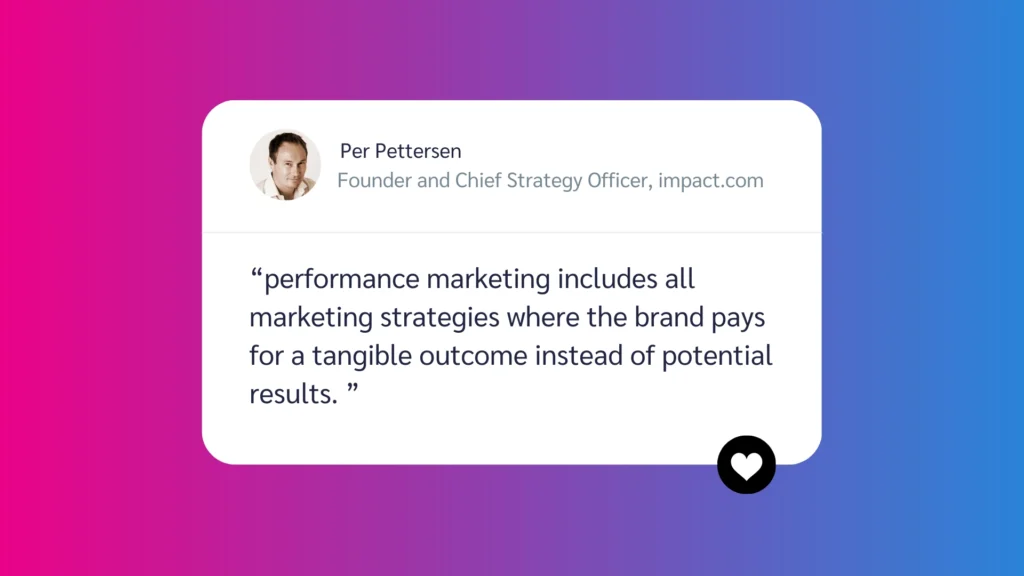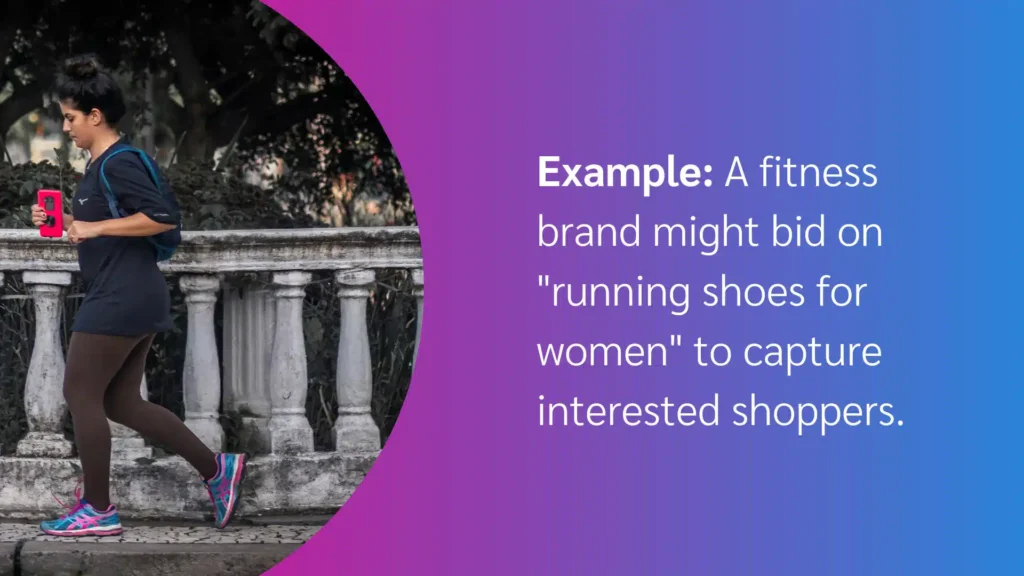Traditional marketing asks you to spend first and hope for the best. But what if you could flip the script and pay for results after they’ve happened? You can, and it’s called performance marketing.
Performance marketing is a broad term for strategies encouraging quick, desired results, such as ad clicks or sign-ups. Think pay-per-click (PPC) advertising and affiliate marketing.
For instance, PPC advertising is such a popular marketing tactic that over 7 million advertisers include it in their campaigns. Performance marketing strategies help increase conversions while giving brands quick wins as they lay the groundwork for their traditional marketing approach.
In reality, your brand needs both traditional and performance marketing. Let’s explore performance marketing in more depth to understand how these strategies play a larger role in a brand’s comprehensive marketing campaign.
Performance marketing: Definition, process, and benefits
Performance marketing is a results-driven strategy where brands only pay when specific actions, such as clicks, leads, or sales, are achieved. This approach focuses on measurable outcomes, enabling businesses to track performance and maximize return on investment (ROI).

Brands use tools such as customized landing pages, campaign codes, and UTM parameters to pinpoint which channels or partners drive results. Real-time analytics help monitor performance and provide insights into what’s working.
When a defined action, such as a sale or a sign-up, is completed, the responsible partner earns a pre-agreed payment. Dedicated performance marketing software, such as impact.com, streamlines this process with robust tracking, comprehensive reporting, and automated payout management.
For example, AppSumo affiliates use personalized affiliate codes to promote AppSumo products to their audience. When a new customer purchases through their link, affiliates earn 100 percent of the sale, up to $50. Beyond that, they can also earn commissions on returning customer purchases ranging from 0 percent to 15 percent.
Image source: @joannayung.co
Comparing the differences between performance and brand marketing
Performance and brand marketing serve distinct purposes, each tailored to achieve specific business goals. While they may overlap in driving overall success, their intentions differ significantly.
Brand marketing centers on building awareness, shaping public perception and fostering strong, long-term relationships between the brand and its audience. On the other hand, performance marketing is all about measurable outcomes. It focuses on driving specific, trackable actions, such as generating leads, click-throughs, or sales.
Here’s a quick breakdown of the key differences between brand marketing and performance marketing:
| Performance marketing | Brand marketing | |
| Objectives | Drive immediate, measurable actions like sales or leads. | Build long-term brand recognition, trust and loyalty |
| Key metrics | ROI, clicks, conversions, leads, or sales. | Brand awareness, audience sentiment, and reach. |
| Time frame | Short-term, focused on immediate results. | Long-term, aiming for sustained growth. |
| Examples | Paid search ads, social media ads, email marketing, affiliate marketing, retargeting campaigns | TV commercials, sponsorships, content marketing, and consistency in branding across touchpoints. |
| Cost structure | Pay-per-action (e.g., clicks, conversions). | Fixed costs, often upfront investments. |
| Effectiveness | Ideal for generating immediate results and scaling in the short term | Crucial for fostering deep customer connections and sustaining growth over the long term. |
| Target audience | Buyers ready to take action. | Broad audience to create positive brand associations and loyalty. |
Top benefits of performance marketing for your business
High ROI. Performance marketing delivers strong returns by focusing on measurable actions like sales or leads, where every dollar spent drives results.
Low-risk. Its pay-for-performance model reduces financial risk, as businesses spend only on campaigns that generate tangible outcomes.
Easy to track. Precise metrics like clicks, conversions, and ROI make monitoring success and optimizing strategies in real-time simple.
Flexible. Campaigns can be adjusted quickly, allowing businesses to respond to market changes, consumer behavior, or performance insights.
Increased brand awareness. While driving conversions, performance marketing also exposes your brand to new audiences, creating recognition alongside measurable results.
While these benefits make performance marketing attractive to brands across industries, understanding the specific channels available is crucial for developing an effective strategy.
Let’s explore the eight primary performance marketing channels that can drive measurable results for your business.
8 types of performance marketing channels you should know
Companies use many digital marketing channels as part of their performance marketing strategies. However, a few channels are specifically designed for these campaigns. These are the most common performance marketing channels brands include in their strategy.
1. Paid search (search engine marketing)
Paid search, or search engine marketing (SEM), is a performance marketing channel where businesses display ads in search engine results pages (SERPs) based on user keyword searches.
How it works
Brands bid on relevant keywords to display ads in search engine results pages (SERPs). Ads trigger when users search for these keywords, with placement determined by bid amount and ad quality. The brand pays only when users click their ads, making it a highly targeted and cost-effective option.

Key benefits
- High intent: Users searching specific keywords are often ready to act, leading to higher conversion rates.
- Measurable results: Platforms like Google Ads track metrics like clicks, conversions, and ROI.
- Precise targeting: Ads can target by demographics, location, and device, creating highly relevant experiences for users.
Common strategies:
- Keyword optimization: Focus on high-intent and long-tail keywords.
- Negative keywords: Exclude irrelevant searches to save budget.
- Demographic targeting: Reach your ideal audience.
- A/B testing: Test different ads to find what works best.
2. Social media advertising
Social media advertising connects brands with highly specific audiences using popular platforms such as Facebook, Instagram, LinkedIn, and TikTok. Businesses can create hyper-targeted campaigns that stand out in a crowded digital space by leveraging user interests, behaviors, and demographic data.
How it works
Brands design tailored ads to integrate seamlessly into users’ social feeds and experiences. These ads are served based on predefined audience traits, such as age, location, or online habits.

Key benefits
- Advanced targeting: Platforms allow businesses to drill down into detailed audience segments, effectively eliminating irrelevant impressions.
- Engagement-driven: Ads can spark meaningful interactions, from likes to shares, creating opportunities for organic reach and brand visibility.
- Transparent performance tracking: Metrics such as reach, engagement, and conversions are accessible in real-time, enabling agile adjustments.
Common strategies
- Lookalike audiences: Attract new prospects by targeting users similar to your current customers.
- Retargeting: Reconnect with individuals who have shown prior interest, such as website visitors or abandoned cart users.
- Creative experimentation: Test varying images, videos, or messages to identify what resonates most.
- Platform customization: Align campaigns with each platform’s strengths—for example, storytelling visuals on Instagram or professional content on LinkedIn.
3. Affiliate marketing
As effective as social media advertising can be for building immediate connections with targeted audiences, affiliate marketing offers a complementary approach by leveraging trusted third-party relationships to extend your brand’s reach.
This performance-driven channel allows businesses to collaborate with affiliates who promote their offerings in exchange for a commission.
How it works:
Affiliates promote a company’s products or services using blogs, websites, social media, or other platforms. Each promotion contains a unique affiliate link that tracks the traffic or sales generated by their efforts.
Image source: Nina Williams blog
Key benefits
- Cost-effective campaigns: Businesses only pay for measurable results, minimizing wasted spend.
- Scalability: A growing network of affiliates can broaden your reach without requiring a proportional increase in investment.
- Targeted marketing: Affiliates often cater to specific niches, connecting your brand with highly relevant audiences.
Common strategies
- Choosing the right affiliates: Work with partners whose audiences align with your target market.
- Structuring commissions effectively: Motivate performance by offering attractive, tiered payout rates.
- Monitoring results: Use analytics platforms to measure conversions, click-through rates, and ROI.
- Providing assets: Supply affiliates with high-quality content, banners, or exclusive offers to optimize their promotions.
4. Email marketing
Reaching customers directly in their inboxes remains one of the most effective ways to drive engagement and conversions. Email marketing revolves around delivering targeted content to audiences to build relationships, nurture leads, and encourage specific actions.
How it works
Brands craft personalized emails tailored to audience preferences and behaviors. Using tools like segmentation, they divide their subscriber lists into specific groups with shared characteristics, delivering targeted messages to the most appropriate audience.

Key benefits
- Direct connection with audiences: Email provides a one-on-one communication channel free of third-party interference.
- Exceptional ROI: For every dollar spent, email marketing can deliver a robust return, often outperforming other channels.
- Customization at scale: Advanced tools enable personalized messaging based on individual customer preferences and interactions.
Common strategies
- Segmentation: Divide your email list into targeted groups to deliver more relevant content.
- A/B testing: Experiment with subject lines, email designs, and calls to action to identify what drives results.
- Automation: Set up triggered workflows, such as welcome series or birthday offers, to engage audiences at key moments.
- Compelling CTAs: Every email should include a clear next step that aligns with your goals.
5. Display advertising
Email marketing excels at nurturing direct relationships with your audience, and display advertising enables brands to expand their visual presence across the wider web ecosystem.
Let’s examine how this traditional yet evolving channel fits into modern performance marketing strategies.
Display advertising uses visually engaging ad formats to attract, inform, and drive action from potential customers. These ads often include images, videos, or other interactive elements to capture attention and encourage clicks.
How it works
Display ads appear on websites, apps, or social media platforms and are served through ad networks, such as Google Display Network or Microsoft Advertising. Advertisers target users based on demographics, online behavior, or specific interests.
When a user interacts with an ad (by clicking or viewing), they’re directed to the advertiser’s landing page or website. Marketers can track display campaigns through metrics like impressions, clicks, and conversions, which directly link results to specific ad performance.

Key benefits
- Visibility at scale: Display networks connect your ads to millions of websites, increasing brand exposure.
- Audience targeting: Leverage precise segmentation options to reach users who match your ideal customer profile.
- Cost control: Flexible bidding options, like pay-per-click (PPC) or cost-per-thousand impressions (CPM), help optimize spending.
- Engagement boost: Eye-catching visuals and call-to-action buttons encourage user interaction and drive traffic.
Common strategies
- Retargeting: Display ads to re-engage users who have visited your website but have not converted, keeping your brand top of mind.
- Dynamic creative optimization: Use ads that automatically adjust to the viewer’s preferences, increasing relevance and engagement.
- Frequency capping: Limit the number of times an ad is shown to an individual to prevent overexposure and improve user experience.
- A/B testing: Run variations of your ads to identify what designs or messaging yield the highest performance.
6. Native advertising
Native advertising seamlessly integrates promotional content within a platform’s organic material, making ads appear a natural part of the user experience. These ads match the form and function of the medium they are displayed on, which often results in higher engagement and less disruption.
How it works
Native ads are designed to mimic the surrounding content they appear with, such as articles, feeds, or search results. They are labeled as sponsored for transparency and are algorithmically placed to reach users with relevant interests, providing higher engagement without interrupting the browsing experience.

Key benefits
- Enhanced user experience: Native ads blend into the content, minimizing interruptions and fostering positive engagement.
- Higher engagement rates: The non-disruptive format often leads to stronger click-through and viewability rates compared to traditional ads.
- Improved trust: By appearing in trustworthy platforms and aligning with relevant content, native ads build credibility with audiences.
- Broad applicability: Native advertising is versatile because it works across a wide array of formats and industries.
Common strategies
- Content alignment: Design ads that align with the platform’s tone and style, making them appear natural and relevant.
- Targeted audience segments: Leverage data to serve ads to users based on their interests, past behaviors, or demographic information.
- Clear disclosure: Mark all native ads as paid or sponsored content to maintain trust and transparency with viewers.
- Storytelling: Use storytelling techniques to make ads informative and engaging, rather than overtly promotional.
7. Influencer marketing (as a performance channel)
Native advertising’s seamless integration creates value by blending into user experiences, but influencer marketing takes this concept further by leveraging authentic personal connections.
Influencer marketing leverages the reach and credibility of individuals with a strong online presence to promote products or services. These influencers can include social media personalities, bloggers, or industry experts who resonate with a specific audience.
How it works
Brands team up with influencers whose content matches their offerings to craft engaging campaigns. Influencers share promotions through posts, videos, or stories, often adding personal experiences. Campaign success is measured by engagement, click-throughs, or sales via unique promo codes or links.
Image source: @apieceofmyglamhome
Key benefits
- Trust-building: Influencers have established credibility with their audience, creating an authentic connection that drives trust.
- Precise targeting: Partnering with niche influencers connects your message with highly relevant and engaged communities.
- Creative storytelling: Content creators bring fresh and engaging approaches to showcasing your product or service.
- High ROI potential: Strategic collaborations with the right influencers can lead to strong returns on your investment.
Common strategies
- Micro-influencers: Collaborate with influencers who have smaller but highly engaged audiences for cost-effective, impactful campaigns.
- Long-term partnerships: Building ongoing relationships with influencers enhances authenticity and maintains consistent brand messaging.
- Product seeding: Provide free products to influencers and encourage them to share organic reviews or testimonials.
- Platform-focused strategies: Tailor your campaigns to fit the unique style and strengths of each platform, such as videos for YouTube or short-form content for TikTok.
How to track and measure performance marketing success
Understanding these eight channels provides the foundation for effective performance marketing, but implementation is only half the equation. To maximize ROI and optimize campaigns, you’ll need robust measurement strategies that align with your business objectives.
Choosing the right KPIs is fundamental to measuring the ROI of a performance marketing campaign. Brands use these metrics to pay partners based on their performance. However, many struggle to define what metrics they should track to measure success.
Here are the most common KPIs brands target with their performance marketing tactics.
Cost per click (CPC) is the amount a brand pays a publisher every time a lead clicks to reach a designated landing page.
Cost per impression (CPM). For CPM—or cost per mile—campaigns, a brand pays a publisher based on how many users see the ad. Usually, CPM campaigns are paid out for every 1,000 views.
Cost per lead (CPL). Companies often measure CPL when a user completes a form, schedules a call, or submits an email address.
Cost per acquisition (CPA) / cost per sales (CPS). When a brand makes a sale through a performance marketing campaign, they pay the partner a flat fee or a percentage of the sale.
Lifetime value (LTV). Brands measure how influential their partners are by assessing LTV. A high LTV shows customers are likely to buy repeatedly from that partner. Some brands pay partners based on how valuable the leads are.
FAQ
Performance marketing is any data-driven marketing activity where a brand pays a publisher, affiliate, or partner when buyers take a predetermined action. These actions are tracked and measured by key performance indicators (KPIs).
- High ROI: Delivers strong returns by focusing on measurable actions.
- Low risk: Pay only for campaigns that achieve results.
- Easy tracking: Metrics like clicks and ROI simplify performance monitoring.
- Flexibility: Quickly adapt campaigns to market or consumer changes.
- Brand awareness: Boosts recognition while driving conversions.
- Paid Search (SEM): Targets high-intent users with keyword-based ads.
- Social Media Ads: Reaches specific audiences with tailored campaigns.
- Affiliate Marketing: Partners promote your brand for a commission.
- Email Marketing: Drives engagement with personalized, direct messages.
- Display Ads: Uses visuals to attract and convert potential customers.
- Native Advertising: Blends ads seamlessly into platform content.
- Influencer Marketing: Leverages trusted creators to promote your brand.
- Cost Per Click (CPC): Tracks the cost of each click to your landing page.
- Cost Per Impression (CPM): Measures the cost for every 1,000 ad views.
- Cost Per Lead (CPL): Calculates the cost of acquiring a new lead.
- Cost Per Acquisition (CPA): Tracks the cost of converting a customer.
- Lifetime Value (LTV): Measures the long-term value of customers acquired.
Increase your marketing impact with performance marketing
Performance marketing is a data-driven approach that allows brands to maximize their marketing budgets and only pay for desired results. Whether brands launch a social media advertising campaign, an email marketing campaign, or partner with influencers, performance marketing strategies help brands reach targeted audiences. It provides a high ROI while also providing clear, measurable insights.
To get the most out of your time and efforts, consider partnering with impact.com. Ecomnia, for example, used the impact.com platform to leverage commerce content placements to increase brand awareness and reach a broader audience, which resulted in a 12.9 percent increase in conversion.
By using performance marketing strategies and adapting as consumer behaviors shift, brands who use performance marketing can easily adjust their strategies without wasting their budget.
Ready to take your performance marketing strategy to the next level? Request a demo and explore how impact.com’s partnership management platform can help you easily track, optimize, and grow your marketing efforts.
Explore additional insights and tools from impact.com to master performance marketing and maximize ROI.
- Affiliate marketing: How to give your business the strategic edge [ebook]
- The convergence strategy: Transforming affiliate and influencer channels to accelerate growth [research blog]
- 6 attribution models for better insights into your customer journey [blog]
- 11 partnership measurement metrics you should know [blog]
- Ultimate guide to influencer marketing [ebook]
- 5 strategies to turn affiliates into high-performing partnerships [blog]
- How merging affiliate and influencer marketing expands reach, strengthens credibility and accelerates conversions [blog]






